
Wine Culture and Information since 2002 - Volume 22
 Wine Culture and Information since 2002 - Volume 22 |
|
BeansThe most famous representatives of legumes, beans are rich in proteins and fibers, a tasty food and an important help for a correct nutrition |
|
With the term bean it is intended a plant of the genus phaseolus belonging to the family of leguminosae. Beans are the seeds of these plants. There are more than 14,000 varieties of beans, most of them originating from South America, and of them, only twenty two are used in cooking. Moreover, there are beans varieties suited to be consumed as whole - that is with the pod - generally called green beans: in this case the bean must be consumed when it has reached full ripeness. Bean plants have in common the rounding shape of leaves and of flowers - white or pink - which bear pods, that is the fruits, with the characteristic stretched shape and at whose inside are found the seeds. The harvesting period varies according to the variety, generally from June to October.
|
|
Beans were known by ancient Greeks and Romans, however these varieties did not belong to the species known today. Beans that were known in ancient times originated from Asia and Africa, they were what we know today as black-eyed beans, of small size, pale color almost white and a small black stain in the point where it is attached to the pod. The beans generally consumed today, originated from Central-Southern America and were introduced in Europe by Spaniard and Portuguese explorers around the sixteenth century, after having been discovered by the famous explorer Christopher Columbus during its second journey to Cuba. In Mexico beans are being cultivated and consumed for more than 7,000 years.
In Europe beans are being consumed since the beginning of the 1500's: they were introduced in Northern Italy, in France and in Germany and it were Europeans to introduce beans in North America. The species of beans originated from South America are Lima bean and common bean. Whoever has the chance to travel to Mexico can notice in local markets are commercialized even twentyfive different varieties of beans. Lima bean was exported in Africa from America during the period of slaves. Spaniards, during the time of their explorations, introduced beans in Asia. Today beans are considered an ingredient of the poor man's cooking, whereas in the 1500's they were mainly consumed by rich and noble classes. Beans were in fact served in the tables of the most rich people and were also used as a gift in special or important occasions. In the Middle Age - when Europe was severely decimated because of famines and epidemics which affected thousands of people - in periods when people had problems in finding food, beans and legumes represented an important source of proteins which could revitalize people severely affected by famines. Legumes - easy to find, to cultivate, with a pretty low price and, in particular, rich in proteins - have literally saved whole generations, while making them more resistant to diseases. Legumes actively contributed to the repopulation of Europe. After the discovery of the New World, the family of legumes in Europe grew up with the arrival of beans. In a painting of Annibale Caracci (1557-1602), titled “il mangiatore di fagioli” (bean eater) and kept at Colonna gallery at Rome, is depicted a man of the people - sat down at a simple and poor table - eating beans. Even in America the importance of beans is strongly associated to the people: one of the 300 Indians tribes is in fact called Papago, that is “bean people”.
|
||||||||
|
Beans have many important properties, not only according to a point of view associated to human metabolism, but also according to an agronomic point of view. Cultivating a land with plants of beans, means enriching it with azote, an important element capable of improving the conditions and the characteristics of the soil. Beans are very nutrient and rich in vitamins A, B, C and E. Concerning vitamin C, it should be remembered it is considerably lost in prolonged cooking. Beans also contains mineral salts and oligo elements, such as potassium, iron, calcium, zinc and phosphor. Just like all the other legumes, beans are rich in lecithin, a phospholipid which favors the emulsion of fats, avoiding their accumulation in blood and therefore reducing the level of cholesterol. Beans are rich in fibers - in particular, soluble fibers - which favors a better digestion. One hundred grams of dry beans provide 24 grams of proteins and 2.5 grams of fats; the same quantity of meat provides 15 grams of proteins and 15 grams of fats. Despite its high nutritional value, it is always advisable to eat beans together with cereals. A given quantity of beans contains 23% of proteins, as opposed to 15-20% of fish and 10-20% of meat, however the proteins of beans, although being quantitatively higher, are qualitatively inferior, because they lack of some essential aminoacids. For this reason our ancestors were used to eat pasta and beans; they matched cereals and beans, which contain the essential aminoacids lacking in beans. The combination of beans and cereals therefore ensures the whole range of essential aminoacids. It should be remembered essential aminoacids are indispensable to our organism for the “construction” of proteins, a process which requires the availability of raw matters, represented by aminoacids. Our organism is capable of “constructing” only twelve of the twenty essential aminoacids, the others must necessarily be got from foods and for this reason are defined as essential. Bean's proteins lack of cysteine, tryptophan and metionine: for this reason they are considered poor, as opposed to the ones of meat which contains them all. However cysteine, tryptophan and metionine are contained in cereals: a quality which makes the matching of beans and cereals very important according to a nutritional point of view. Beans are made of 60% of starches and sugar, whereas green beans are made of 90% of water, therefore their content in proteines is lesser than beans, however they contain a higher quantity of mineral salts and vitamin A. Beans are useful for obesity as 100 grams provides the same calories of 80 grams of pasta and of 120 grams of bread and, moreover, they are richer in fibers. Beans help to recover kidney functions thanks to the oligo elements they contain. With bean's pods can be prepared a tisane which can help to reduce the cholesterol in blood and to lower blood pressure, as well as having an antibacterial effect.
|
||||
|
The number of beans varieties used for human nutrition is pretty high. Following is a short list of the most common varieties:
|
|
Beans are usually commercialized both fresh and dry, or canned. Whenever possible, it is always suggested the consumption of dry beans - although this requires the necessary operation of soaking - because they have a better and superior taste than canned beans. Fresh beans, in order to keep their organoleptic qualities, must be removed from the pod soon before being cooked. This operation avoids - of better to say, limits as much as possible - the contact of the skin with the air therefore avoiding its hardening. Fresh beans can be kept in the freezer after having been put in boiling water for some minutes. Fresh beans are cooked by pouring them in cold water, the pot will be then covered and allow water to boil: cooking times will vary according to quality. Dry beans are usually commercialized without pods. In order to soften the skin, it is appropriate to soak them for about 12-24 hours in lukewarm water. During the soaking, water should be replaced two times and it must not be used for cooking. Green beans can be boiled in abundant boiling water for a time usually from 20 and 30 minutes. Cooking methods for beans and basically two: stewing and boiling. Cooking times are pretty variable. Borlotto bean requires about 40 minutes of cooking time, Spanish beans requires about one hour and a half, whereas dried beans requires about two or three hours. These are - of course - indicative times and that can change in case of particular recipes. Dry beans, before being cooked, must be selected, every extraneous body should be removed, including the ones showing holes or wrinkles, a characteristic which could signal the presence of parasites. Moreover, it is good to check for the absence of humidity because beans kept in wet places can develop toxic molds. Beans can be kept up to one year and in dry places, shielded from light. After this period, beans will begin to lose their best organoleptic and nutritional qualities. Beans have disappeared from the table of our times because of the annoying “side effect” of bowl meteorism, a characteristic which deprived modern nutrition of important supply of fibers and proteins. Meteorism is caused by bean's fibers - which are not absorbed by the organism - and when they are in the bowl produce gas. For this reason, the consumption of beans is not advised to anyone suffering of this problem. A method to avoid meteorism, consists in sieving part of the beans. It is enough to sieve just a part of them because in the skins are found enzymes useful for digestion, moreover it is advisable to cook beans with thyme, cumin, laurel and onion, that is the herbs which have the effect of promoting digestion and the expulsion of intestinal gases. The consumption of beans it is not suggested to anyone. In case of arthritis, arthrosis, gout, kidney stones and excess of uric acid, it is always recommended to limit or avoid the consumption of beans. In this cases can be consumed green beans, which contains a lot of water and a low quantity of proteins. Finally, it should be remembered beans are generally consumed cooked because some varieties - in case they are consumed raw - can have toxic effects.
|
AquavitaeReview of Grappa, Distillates and Brandy |
|
|
| Distillates are rated according to DiWineTaste's evaluation method. Please see score legend in the "Wines of the Month" section. |
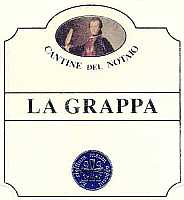
|
|
Grappa di Aglianico del Vulture Bianca |
|
| Cantine del Notaio (Basilicata, Italy) | |
| (Distiller: Distillerie G. Bertagnolli) | |
| Raw matter: Pomace of Aglianico del Vulture | |
| Price: € 25.00 - 50cl | Score: |
| This grappa is colorless, limpid and crystalline. The nose reveals intense, clean and pleasing aromas of blackberry, raspberry, prune, hazelnut and walnut husk, with almost imperceptible alcohol pungency. In the mouth has intense flavors, good roundness, perceptible alcohol pungency which tends to dissolve rapidly, agreeable and balanced sweet hint. The finish is persistent with flavors of prune and blackberry. This grappa is produced with bainmarie discontinuous steam operated alembic still. Alcohol 42%. | |
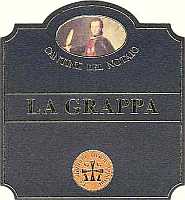
|
|
Grappa di Aglianico del Vulture Affinata |
|
| Cantine del Notaio (Basilicata, Italy) | |
| (Distiller: Distillerie G. Bertagnolli) | |
| Raw matter: Pomace of Aglianico del Vulture | |
| Price: € 31.00 - 50cl | Score: |
| This grappa shows an intense amber yellow color, limpid and crystalline. The nose reveals intense, clean, pleasing and refined aromas of vanilla, chocolate, caramel, prune, hazelnut, almond, honey, black cherry and tobacco, with almost imperceptible alcohol pungency. In the mouth has pleasing roundness and intense flavors, perceptible alcohol pungency which tends to dissolve rapidly, good correspondence to the nose, pleasing and balanced sweet hint. The finish is persistent with flavors of prune, licorice, almond and honey. A well made grappa produced with discontinuous method in steam operated alembic stills and aged in barrique for about 30 months. Alcohol 42%. | |
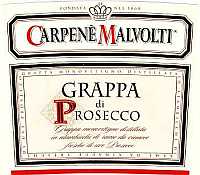
|
|
Grappa di Prosecco |
|
| Carpenè Malvolti (Veneto, Italy) | |
| Raw matter: Pomace of Prosecco | |
| Price: € 11.00 - 50cl | Score: |
| This grappa is colorless, limpid and crystalline. The nose reveals intense, clean and pleasing aromas of pear, apple, hazelnut, wistaria and banana, with almost imperceptible alcohol pungency. In the mouth has intense flavors, with perceptible alcohol pungency which tends to dissolve rapidly, good correspondence to the nose, good roundness, pleasing and balanced sweet hint. The finish is persistent with flavors of pear, apple and banana. This grappa is produced with steam discontinuous alembic still. Alcohol 40%. | |
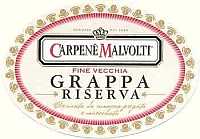
|
|
Grappa Riserva |
|
| Carpenè Malvolti (Veneto, Italy) | |
| Raw matter: Selection of aged grappas | |
| Price: € 11.00 - 70cl | Score: |
| This grappa shows a pale straw yellow color, limpid and crystalline. The nose reveals intense, clean and pleasing aromas of pear, vanilla, hazelnut, honey, licorice and banana, with almost imperceptible alcohol pungency. In the mouth has intense flavors, with perceptible alcohol pungency which tends to dissolve rapidly, good correspondence to the nose, pleasing and balanced sweet hint. The finish is persistent with flavors of licorice and hazelnut. This grappa is distilled with steam operated discontinuous alembic still and ages in cask. Alcohol 40%. | |
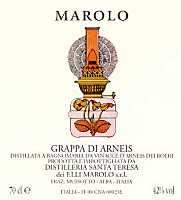
|
|
Grappa di Arneis 2003 |
|
| Santa Teresa Marolo (Piedmont, Italy) | |
| Raw matter: Pomace of Arneis | |
| Price: € 26.00 - 70cl | Score: |
| This grappa is colorless, limpid and crystalline. The nose denotes intense, clean and pleasing aromas of hazelnut, pear, broom, dog rose, peach and banana, with almost imperceptible alcohol pungency. In the mouth has intense flavors and pleasing smoothness, perceptible alcohol pungency which tends to dissolve rapidly, good correspondence to the nose, agreeable and balanced sweet hint. The finish is persistent with flavors of hazelnut and pear. This grappa is distilled in bainmarie discontinuous alembic still. Alcohol 42%. | |
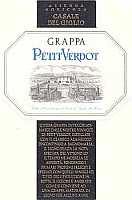
|
|
Grappa Petit Verdot |
|
| Casale del Giglio (Latium, Italy) | |
| (Distiller: Distilleria Pilzer) | |
| Raw matter: Pomace of Petit Verdot | |
| Price: € 12.00 - 50cl | Score: |
| This grappa shows a pale amber yellow color, limpid and crystalline. The nose reveals intense, clean and pleasing aromas of vanilla, licorice, hazelnut, prune, honey, raspberry, walnut and honey, with almost imperceptible alcohol pungency. In the mouth is agreeable and has intense flavors, with perceptible alcohol pungency which tends to dissolve rapidly, good correspondence to the nose, pleasing roundness, balanced sweet hint. The finish is persistent with flavors of honey, licorice and prune. This grappa is distilled with bainmarie discontinuous alembic still and ages in cask for some years. Alcohol 43%. | |
Wine Parade |
|
|
| The best 15 wines according to DiWineTaste's readers. To express your best three wines send us an E-mail or fill in the form available at our WEB site. |
| Rank | Wine, Producer | |
|---|---|---|
| 1 |
| Palazzo della Torre 2000, Allegrini (Italy) |
| 2 |
| Montepulciano d'Abruzzo Riparosso 2001, Illuminati (Italy) |
| 3 |
| Aglianico del Vulture La Firma 2002, Cantine del Notaio (Italy) |
| 4 |
| Chablis Grand Cru Les Clos 2002, Domaine Billaud-Simon (France) |
| 5 |
| Riesling Cuvée Frédéric Emile 1999, Maison Trimbach (France) |
| 6 |
| Amarone della Valpolicella Classico 1998, Santa Sofia (Italy) |
| 7 |
| Trento Talento Brut Riserva Methius 1998, Dorigati (Italy) |
| 8 |
| Colli Orientali del Friuli Rosazzo Bianco Terre Alte 2002, Livio Felluga (Italy) |
| 9 |
| Harmonium 2001, Firriato (Italy) |
| 10 |
| Riesling Central Otago 2004, Felton Road (New Zealand) |
| 11 |
| Edizione Cinque Autoctoni 2001, Farnese (Italy) |
| 12 |
| Brunello di Montalcino 1999, Castello Banfi (Italy) |
| 13 |
| Amarone della Valpolicella Classico 2000, Zenato (Italy) |
| 14 |
| Riesling Spätlese Nierstein Brudersberg 2003, Weingut Freiherr Heyl Herrnsheim (Germany) |
| 15 |
| Conte Bolani 2001, Tenuta Ca' Bolani (Italy) |
|
||||||||
|
DiWineTaste Polls
|
| |||||||
Privacy Policy | |||||||


| Copyright © 2002-2024 Antonello Biancalana, DiWineTaste - All rights reserved |
| All rights reserved under international copyright conventions. No part of this publication and of this WEB site may be
reproduced or utilized in any form or by any means, electronic or mechanical, without permission in writing from DiWineTaste. |